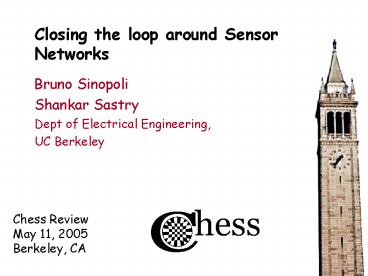Closing the loop around Sensor Networks - PowerPoint PPT Presentation
1 / 29
Title:
Closing the loop around Sensor Networks
Description:
Closing the loop around Sensor Networks – PowerPoint PPT presentation
Number of Views:47
Avg rating:3.0/5.0
Title: Closing the loop around Sensor Networks
1
Closing the loop around Sensor Networks
- Bruno Sinopoli
- Shankar Sastry
- Dept of Electrical Engineering,
- UC Berkeley
2
Conceptual Issues
- Given a certain wireless sensor network can we
successfully design a particular application? - How does the application impose constraints on
the network? - Can we derive important metrics from those
constraints? - How do we measure network parameters?
3
What can you do with a sensor network?
- Literature provides key asymptotic results
- We are interested in answering different semantic
questions, e.g. - At the algorithmic level
- How much packet loss can a tracking algorithm
tolerate? - At the network level
- How many objects can a particular sensor network
reliably track?
4
Wireless Sensor Networks
- Its a network of devices
- Many nodes 103-105
- Multi-hop wireless communication with adjacent
nodes - Cheap sensors
- Cheap CPU
- Issues w/ Sensor Networks and Data Networks ?
- Random time delay
- Random arrival sequence
- Packet loss
- Limited Bandwidth
5
Control Applications with Sensor Networks
Pegs
Power Grids
HVAC systems
Human body
6
Sensor net increases visibility
Control and communication over Sensor Networks
Computational unit
7
Experimental results Pursuit evasion games
8
Problem Statement
- Given a control systems where components, i.e.
plant, sensors, controllers, actuators, are
connected via a specified communication network,
design an optimal controller for the system
9
Outline
- Problem Statement
- Optimal Estimation with intermittent observations
- Optimal control with both intermittent obs and
control - TCP-like protocols
- UDP-like protocols
- Conclusions
10
Modeling
11
Assumptions
- System
- Discrete time linear time invariant
- Additive white gaussian noise on both the
dynamics and the observation - Communication network
- Packets either arrive or are lost within a
sampling period following a bernoulli process. - A Delay longer than sampling time is considered
lost. - Packet Acknowledgement depends on the specific
communication protocol
12
Optimal estimation with intermittent observations
Communication Network
State estimator
Plant
Aggregate Sensor
Kalman Filter
- Main Results (IEEE TAC September 2004)
- Kalman Filter is still the optimal estimator
- We proved the existence of a threshold phenomenon
g
g
³
P
P
E
0
condition
initial
some
and
0
for
lim
c
t
0
t
g
g
³
lt
"
P
t
M
P
E
0
condition
initial
any
and
1
for
c
P
t
0
0
1
g
gmax
gmin
-
1
c
l
)2
(
max
13
Optimal control with both intermittent
observations and control packets
Plant
Aggregate Sensor
Communication Network
Communication Network
Controller
State estimator
- What is the minimum arrival probability that
guarantees acceptable performance of estimator
and controller? - How is the arrival rate related to the system
dynamics? - Can we design estimator and controller
independently? - Are the optimal estimator and controllers still
linear? - Can we provide design guidelines?
14
Control approach
- The problem of control is traditionally
subdivided in two sub-problems - Estimation
- Allows to recover state information from
observations - Control
- Given current state information, control inputs
are provided to the actuators - The separation principle
- allows, under observability conditions, to
design estimator and controller independently. - If separation principle holds, optimal estimator
(in the minimum variance sense) and optimal
controller (LQG) are linear and independent
15
LQG control with intermittent observations and
control
Plant
Aggregate Sensor
Communication Network
Communication Network
Controller
State estimator
Ack is always present
Ack is relevant
Well group all communication protocols in two
classes TCP-like (acknowledgement is
available) UDP-like (acknowledgement is absent)
16
LQG mathematical modeling
?,? Bernoulli, indep.
Minimize J_N subject to
- TCP Transmission Control Protocol
- PRO feedback information on packet delivery
- CONS more expensive to implement
- UDP User Datagram Protocol
- PRO simpler communication infrastructure
- CONS less information available
17
Estimator Design
TCP
UDP
Prediction Step
Correction Step
18
LQG Controller Design TCP case
- Solution via Dynamic Programming
- Compute the Value Function tN and move backward
- Find Infinite Horizon by taking N?1
Vt(xt) minimum cost-to-go if in state xt at
time t
19
LQG Controller Design TCP case
- We can prove that for TCP the value function can
be written as - with
- Minimization of v(t) yields
20
LQG Controller Design TCP case
Stochastic variable !!
21
Infinite Horizon TCP case
OPTIMAL LQG CONTROL
1
bounded
unbounded
time-varying estimator gain
constant controller gain
1
22
Special Case LQG with intermittent observations,
Plant
Aggregate Sensor
Communication Network
Controller
State estimator
1
1
bounded
unbounded
1
23
LQG Controller Design UDP case
Scalar system, i.e. x2R
tN
tN-1
24
LQG Controller Design UDP case
tN-2
NONLINEAR FUNCTION OF INFORMATION SET It
25
UDP controller Estimator designSpecial case C
invertible, R0
Without loss of generality I can assume CI
prediction
correction
26
UDP special caseC invertible, R0
It is possible to show that
27
UDP Infinite HorizonC invertible, R0
It is possible to show that
Necessary condition for boundedness
1
bounded
unbounded
Sufficient only if B invertible
1
28
Conclusions
- Closed the loop around sensor networks
- General framework applies to networked control
system - Solved the optimal control problem for full state
feedback linear control problems - Bounds on the cost function
- Transition from state boundedness to instability
appears - Critical network values for this transition
29
Thank you !!!
- For more info sinopoli_at_eecs.berkeley.edu
- Related publications
- Kalman Filtering with Intermittent Observations
- -IEEE TAC September 2004
- Time Varying Optimal Control with Packet Losses
- -IEEE CDC 2004
- Optimal Control with Unreliable Communication
the TCP Case - -ACC 2005
- LQG Control with Missing Observation and Control
Packets - -IFAC 2005

